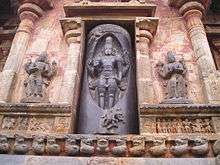Lingodbhava
| Lingodbhava | |
|---|---|
 Image of Lingodbhava in the Airavatesvara Temple at Darasuram, 10th century CE | |
| Region | South India |
Lingodbhava ("emergence of the Linga") is an iconic representation of Hindu god Shiva, commonly seen in the South Indian Hindu temples. The icon depicts the legend of the origin of the linga, Shiva's aniconic representation that is often in his worship. The tale of Lingobhava is found in various puranas, augments the synthesis of the old cults of pillar and phallic worship. The earliest literary evidence of the iconic representation is found in the 7th century works of Shaiva saints Appar and Thirugnana Sambandar.
Legend
Once, while the deities Vishnu and Brahma contested for superiority, Shiva appeared as a flame, and challenged them to find his source.[1][2] Brahma took the form of a swan, and flew to the sky to see the top of the flame, while Vishnu became the boar Varaha, and sought its base. The scene is called Lingodbhava and is represented in the western wall at the sanctum of most Shiva temples. Neither Brahma nor Vishnu could find the source, and while Vishnu conceded his defeat, Brahma lied and said he had found the pinnacle. In punishment, Shiva ordained that Brahma would never have temples on earth in his worship.[1]
Iconography
The Lingobhava image can be found in the first precinct around the sanctum in the wall exactly behind the image of Shiva in the central shrine. Lingobhava or emergence of the Lingam, found in various puranas, augments the synthesis of the old cults of pillar and phallic worship.[3] The idea emerged from deity residing in a pillar and later visualised as Shiva emerging from the lingam.[4]
Literary mention
Appar, one of the early Shaiva saint of the 7th century, gives evidence of this knowledge of puranic episodes relating to Lingodbhava form of Shiva while Tirugnana Sambandar refers this form of Shiva as the nature of light that could not be comprehended by Brahma and Vishnu.[5]
Notes
- 1 2 Aiyar 1982, pp=190–191
- ↑ "Tiruvannamali Historical moments". Tiruvannamalai Municipality. 2011. Retrieved 6 September 2012.
- ↑ Anand 2004, p. 132
- ↑ Vasudevan 2003, p. 105
- ↑ Parmeshwaranand 2001, p. 820
References
- Anand, Swami P.; Swami Parmeshwaranand (2004). Encyclopaedia of the Śaivism. New Delhi: Sarup & Sons. ISBN 81-7625-427-4.
- Parmeshwaranand, Swami; Swami Parmeshwaranand (2001). Encyclopaedic Dictionary of Puranas: Volume 3.(I-L). New Delhi: Sarup & Sons. ISBN 81-7625-226-3.
- Vasudevan, Geetha (2003). The royal temple of Rajaraja: an instrument of imperial Cola power. New Delhi: Abhinav Publications. ISBN 81-7017-383-3.